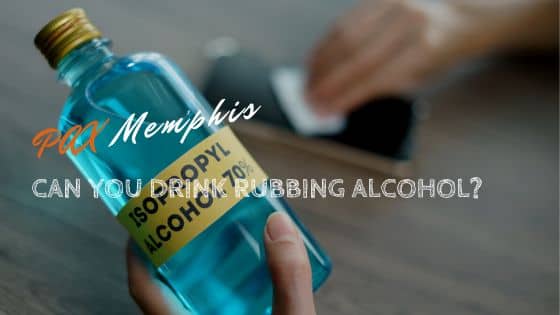Isopropyl alcohol, or rubbing alcohol, is a common household product containing isopropanol. Isopropanol is a clear, colorless liquid with a strong bitter taste. It is used in many cleaning products, disinfectants, hand sanitizers, perfumes, and other products such as solvents, inks, lotions, and antifreeze.
Although different from the alcohol consumed in alcoholic beverages, isopropyl can cause intoxication, but with some serious risks. In fact, isopropanol ingestion is the most common cause of toxic alcohol ingestion reported to the Poison Control Centers yearly. While more than 80% of these cases are unintentional, a portion of these cases occur after people drink rubbing alcohol intentionally.[1]
Drinking rubbing alcohol is extremely dangerous and can result in severe health complications including death. If you or someone you love has consumed rubbing alcohol, call Poison Control (1-800-222-1222) or seek help from a medical professional immediately.
Understanding Isopropyl Alcohol
Isopropyl alcohol is often called “rubbing alcohol” because of its ability to strip paint and grease off surfaces. It is available over the counter in a range of purity levels. Most rubbing alcohol is 30% water and 70% isopropyl alcohol, but some household versions can range from 60-95% isopropanol. However, rubbing alcohol also comes in concentrated levels of up to 99% isopropyl alcohol.
Isopropyl alcohol is produced differently than ethanol or ethyl alcohol, the type of alcohol you find in wine, beer, and spirits. Ethyl alcohol is produced through a process of sugar fermentation and distillation, while isopropyl alcohol is created in a lab specifically for sterilization purposes. Isopropyl alcohol is not meant for human consumption.[2]
Why Do People Drink Rubbing Alcohol in the First Place?
Rubbing alcohol (isopropanol) is a much stronger, more potent form of alcohol than drinking alcohol (ethanol). When consumed, rubbing alcohol is absorbed in the bloodstream more quickly than ethanol, resulting in quicker and more intense intoxicating effects. These characteristics are part of why drinking isopropyl alcohol is so dangerous.
Rubbing alcohol is cheap, easy to find, and accessible to anyone who can get to a grocery store or pharmacy. People who are addicted to alcohol, but have run out of alcoholic beverages and are desperate to get drunk, may drink rubbing alcohol to get intoxicated. Others may drink rubbing alcohol in an act of self-harm.
Why is Drinking Isopropyl Alcohol So Dangerous?
Isopropanol has faster and stronger intoxicating effects than ethanol (the type of alcohol found in beverages. As a result, it is more likely to cause side effects such as slurred speech, sedation, stumbling, and impaired judgment. Rubbing alcohol is also more likely to lead to alcohol poisoning. In fact, people have died of alcohol poisoning after drinking as little as one pint of isopropyl alcohol.[3]
Potential side effects of drinking rubbing alcohol include:
- Constricted pupils
- Stomach pain
- Vomiting
- Throat pain and irritation
- Dizziness
- Red skin
- Increased heart rate
- Poor coordination
- Low body temperature
- Low blood pressure
- Seizures
- Heart attack
- Coma
- Death
When consumed, isopropanol is metabolized into acetone, the toxic liquid solvent found in nail polish removers and paint and varnish removers. Acetone can irritate the gastrointestinal tract causing symptoms like abdominal pain, diarrhea, nausea, bleeding in the intestines and stomach, and rupture of the bladder. Like alcohol, acetone acts as a central nervous system (CNS) depressant, causing dizziness, sedation, headaches, or coma.
While drinking even small amounts of rubbing alcohol is dangerous, drinking large volumes can affect cardiac function leading to internal bleeding, organ damage, shock, and death. Whether intentionally or unintentionally, consuming isopropyl alcohol is considered a medical emergency and requires immediate medical attention.
Can You Get Drunk By Drinking Rubbing Alcohol?
Rubbing alcohol may produce similar effects as the alcohol found in beer, wine, and spirits, but the adverse risks are not worth the intoxication. The intoxicating effects of rubbing alcohol usually appear 30-60 minutes after ingestion, but they’re likely to be accompanied by vomiting, diarrhea, throat and abdominal pain, and even seizures, heart attack, coma, or death.
Symptoms of Alcohol Poisoning
Alcohol poisoning can occur after you drink too much of any kind of alcohol, but consuming rubbing alcohol does increase the risk. Symptoms of alcohol poisoning include:[4]
- Confusion
- Vomiting
- Seizures
- Slow breathing
- Irregular breathing
- Blu-ish skin or pale skin
- Low body temperature
- Loss of consciousness
Alcohol poisoning is an emergency, so it’s important to call 911 and explain the situation to them (including what kind and how much alcohol the person drank). Do not leave the affected person’s side, and if they are vomiting, help them sit up to avoid choking. If the person is already lying down or cannot sit up, turn them on their side and stay with them until help arrives.
Find Help for Alcohol Abuse and Alcoholism Today
If you or someone you love are struggling with alcoholism, please don’t hesitate to reach out for help. Our qualified admissions specialists at PAX Memphis are available 24 hours a day to take your call and help you find the alcoholism treatment you need. Call now to get started.
References:
- https://www.ncbi.nlm.nih.gov/books/NBK493181/
- https://cws.auburn.edu/shared/files?id=227&filename=Ethanol%20and%20Isopropyl%20Alcohol%20FAQs.pdf
- https://nap.nationalacademies.org/read/690/chapter/12#57
- https://www.niaaa.nih.gov/publications/brochures-and-fact-sheets/understanding-dangers-of-alcohol-overdose
Medically Reviewed: September 25, 2019

All of the information on this page has been reviewed and verified by a certified addiction professional.










